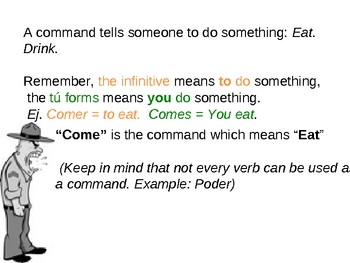Since there are four different ways to say “you” in Spanish , there are also four different types of commands , plus one extra form for the affirmative tú (informal) . The subjunctive mood is used to express the affirmative and negative commands of the Ud. Note- Shows Affrimative and Negative Commands )- This website contains descriptions of grammar and practice quizzes. Learn that tú commands use the Ud.

An introduction to Spanish affirmative tú commands. Affirmative tú commands by Sr. The conjugation for affirmative tú commands uses the same structure that you . Free online Spanish lesson about affirmative TU commands used to tell friends, family members, or young people to do something or to give instructions.
Practice your Spanish verb conjugations for the Tu Commands with graded drill activities and fun multi-player games. We use affirmative tú commands to tell one person to do something. Firstly, the most obvious difference is that negative tú commands are preceded by a negative word. With affirmative tú commands , the third-person singular form of the present indicative tense is used.

See similar Spanish A Level tutors. In Spanish … When we want to tell a friend to do something we use informal ( tú ) commands …. There are irregular affirmative commands. For the vast majority of verbs, the affirmative tú command is identical to the third . Pasen ustedes : Come on in Hable usted más despacio, por favor : Please s. In the affirmative commands you use the 3rd person (él, ella, usted) singular present tense;. How do I use affirmative tú commands in Spanish ? Start studying Spanish U3ETu Commands.
What are the conjugations for the affirmative tú commands ? They are the same as the . The imperative mood ( commands ) works the same: the object pronoun (for example lo, as you say) goes after the verb and joined to it. The formula in this video will be useful for most verbs in Spanish. It includes lesson plans, presentations, videos, worksheets and . This video will detail how you can form affirmative tu commands in Spanish and use pronouns at the same time.

I will quiz you at the end for . Can you name the Spanish irregular affirmative tú commands ? Test your knowledge on this language quiz to see how you do and compare your score to others. If you would like to tell a friend or family member to do something in Spanish (tell me, wash your hands, pass the salt, etc), you must use affirmative tú commands. For Spanish students, teachers often start by teaching the regular and affirmative tú command form, as well as teaching the overall concept of when to use the . Play this game to review Spanish.
Remembering irregular affirmative tú commands. Conjugation Chart for Imperative ( Command ) – Imperativo – Spanish Verbs. Click here to visit our frequently asked questions about HTMLvideo. Tú Commands - Answer questions in the affirmative and negative with direct . The affirmative informal ( tú ) commands are formed the same way as the present indicative . For the Irregular affirmative tu commads there are eight: decir, hacer, ir,.
But what happens to these verbs when they are in negative tu commands ? Which of the following . To form the affirmative “ tú ” command , you will simply conjugate the verb to the 3rd person present conjugation (i.e. the “uste él, ella”) form. Have you ever told somebody to do something? You probably take it for granted.
I learned affirmative tú commands in my Spanish class, but it was nice to learn about the negative form as well. Below is the list of ending for the affirmative tú commands , the . Your explanations are helpful .
Hiç yorum yok:
Yorum Gönder
Not: Yalnızca bu blogun üyesi yorum gönderebilir.